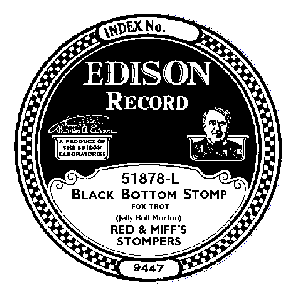Thomas A. Edison, Inc.,
Mid to Late 1920s "Diamond Disks"

 EDI: Even though it was Thomas Edison who invented the first functioning recording system, he was slow to market and perfect his invention, which fell upon others to do. But, not one to lose out on a good thing, he got into the recording of popular music early, and had created the first coin operated juke boxes in the 1880s, (cylinder). He stuck with his cylinder records until the late 20s, when he ceased all record production at the onset of the depression. He grudgingly got into the manufacturing of disk records in 1912 when he FINALLY realized that was what the public wanted.
EDI: Even though it was Thomas Edison who invented the first functioning recording system, he was slow to market and perfect his invention, which fell upon others to do. But, not one to lose out on a good thing, he got into the recording of popular music early, and had created the first coin operated juke boxes in the 1880s, (cylinder). He stuck with his cylinder records until the late 20s, when he ceased all record production at the onset of the depression. He grudgingly got into the manufacturing of disk records in 1912 when he FINALLY realized that was what the public wanted.
But he did it his way. His recording techniques made use of the vertical "hill & dale" style of recording which was used on his cylinder records. Almost all other labels were recording "laterally", with the needle moving back and forth instead of up and down as in the vertical method. Pathe and early OKehs were other examples of Vertically recorded disks. To further complicate things, Edison records were almost four times as thick as other records, and utilized a microgroove which required a diamond stylus and special sound box. One can only imagine the numbers of thick Edison records butchered by playing them on a conventional acoustic phonographs of the day. Of course, the Edison records were no doubt the finest example of acoustic recording technology for its time.
These records were the Betamax of the day; Superior sound reproduction achievable by special proprietary equipment made by Edison, (with a handful of second-party add-ons for other systems). And like Sony, the creators of Betamax, the first home VCRs, Edison kept tight control over his technology.
It was rumored that he and Mrs. Edison personally chose which artists would be recorded on the Edison label, so it is heartening to know that they liked Red & Miff! To bad more famous folks didn't record on those thick platters.
This image is an example of Tom's paper labels, introduced in the early 20s. Prior to this, the "Label" was embossed into the shellac as a sort of a bas-relief deal complete with a half tone of Tom! It has been rumored that the little checker pattern around the label was for setting the proper speed with a strobe light. But our staff Edisonian refutes that assertion. More likely, it was Edison's own variation of Autograph Record's label design from the same period. At any rate, it was purely for design, and not function. This speed was Edison's "standard" 80 rpm. The top "Index No." is indented into the label. And the other number on the bottom most likely refers to something I don't know about. Anyone know what these two numbers refer to? Drop me a line by e-mail.
"Red & Miff's Stompers," was one of the many pseudonyms that Loren "Red" Nichols recorded under, (with trombonist Miff Mole). The most famous of these being "The Five Pennies." "Black Bottom Stomp" was written by Ferdinand "Jelly Roll" Morton. As for the other artist on this date, one could only guess, since many of jazz's greatest artists recorded with Nichols over the years, and I lack the data from this session.
Red & Miff went on to bigger an better things of course, with Miff ending up as lead `bone for the NBS Symphony Orchestra in the 40s. Red continued recording with various "Five Pennies" until his death in 1965.

Return to the W.A.M.S. Home Page